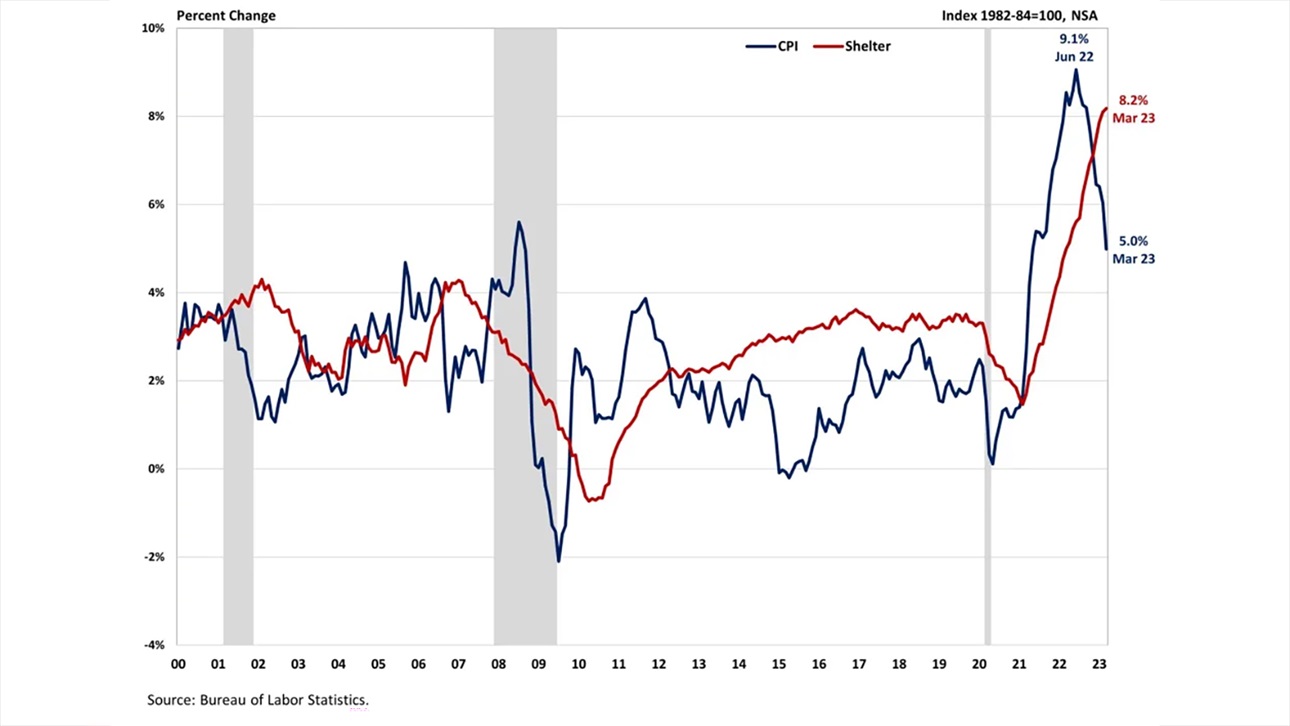Inflation and Rising Housing Costs Show Signs of Cooling
The overall inflation rate, along with the cost of housing, showed signs of cooling in March, with the shelter index (housing inflation) experiencing its smallest monthly gain since November 2022. Still, housing in March continued to be the largest contributor to the overall inflation rate, accounting for more than 60% of the increase when excluding the volatile food and energy sector.
The data is also a clear sign that the Federal Reserve’s ability to address rising housing costs is limited, as shelter cost increases are driven by a lack of affordable supply and increasing development costs. Additional housing supply is the primary solution to tame housing inflation.
And further Fed tightening of monetary policy will hurt housing supply by increasing the cost of acquisition, development and construction (AD&C) financing. This can be seen on the graph below, as shelter costs continue to rise despite Fed policy tightening. Nonetheless, the NAHB forecast expects to see shelter costs decline later in 2023.

The Bureau of Labor Statistics (BLS) reported that the Consumer Price Index (CPI) rose by 0.1% in March on a seasonally adjusted basis, following an increase of 0.4% in February. The index for shelter, which makes up more than 40% of the “core” CPI (core defined as the change in prices of goods and services, except for those from the food and energy sectors), rose by 0.6% in March, following an increase of 0.8% in February.
The indexes for owners’ equivalent rent (OER) and rent of primary residence both increased by 0.5% over the month. Monthly increases in OER have averaged 0.6% over the last three months. These gains have been the largest contributors to headline inflation in recent months.
During the past 12 months, on a not seasonally adjusted basis, the CPI rose by 5% in March, following a 6% increase in February. This was the slowest annual gain since May 2021. The core CPI increased by 5.6% over the past year, following a 5.5% increase in February. The food index rose by 8.5%, while the energy index fell by 6.4% over the past 12 months.
NAHB economist Fan-Yu Kuo provides more analysis in this Eye on Housing blog post.
Latest from NAHBNow
Dec 23, 2025
Lumber Capacity Has Peaked for 2025An annual revision to the Federal Reserve G.17 Industrial Production report shows current sawmill production levels above 2017 by 7.5%, but just 0.3% above 2023 levels.
Dec 22, 2025
Can Offsite Housing Solve the Housing Affordability Crisis?Offsite construction – a method in which components are planned, designed, fabricated in a factory setting and then transported and assembled onsite – is something more community-based organizations (CBOs) are turning to as a solution to the housing affordability crisis.
Latest Economic News
Dec 22, 2025
State-Level Employment Situation: September 2025In September 2025, nonfarm payroll employment was largely unchanged across states on a monthly basis, with a limited number of states seeing statistically significant increases or decreases. This reflects generally stable job counts across states despite broader labor market fluctuations. The data were impacted by collection delays due to the federal government shutdown.
Dec 19, 2025
Existing Home Sales Edge Higher in NovemberExisting home sales rose for the third consecutive month in November as lower mortgage rates continued to boost home sales, according to the National Association of Realtors (NAR). However, the increase remained modest as mortgage rates still stayed above 6% while down from recent highs. The weakening job market also weighed on buyer activity.
Dec 18, 2025
Lumber Capacity Lower Midway Through 2025Sawmill production has remained essentially flat over the past two years, according to the Federal Reserve G.17 Industrial Production report. This most recent data release contained an annual revision, which resulted in higher estimates for both production and capacity in U.S. sawmills.
